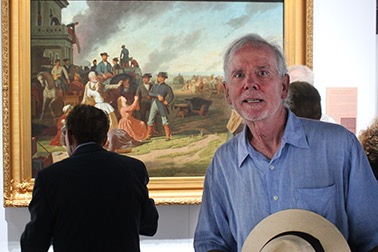Musical Chairs
May 2022

I had come to say goodbye.
Tom’s back was to Pickard Hall. The building looked strong for its 127 years, having received a facelift two decades ago when it still housed the Museum of Art and Archaeology. But its walls had an incurable illness.
During the early days Pickard Hall was the chemistry building. Research experiments leaked radium into the old building’s basement. The wrecking ball was summoned to smash Pickard Hall to fist-sized bricks.
So museum curators prepared to move the museum. They gathered and packed more than 16,000 priceless relics of form, function and fashion spanning seven millenia—ancient pottery and sculptures, jewelry and coins, and some fun surprises, including George Romney’s portrait of Lady Hamilton, who was Admiral Nelson’s mistress and “the pinup girl of the time,” according to Bruce Cox, the museum’s interim director.
The museum’s collections are stunning, from Andy Warhol photographs of Deborah Harry and Kathleen Turner relaxing in public, to a platter designed by Pablo Ruiz Picasso. His full name is not Pablo Ruiz Picasso; it’s Pablo Diego José Francisco de Paula Juan Nepomuceno María de los Remedios Cipriano de la Santísima Trinidad Clito Ruiz y Picasso. Great password.
Like Picasso’s name, the Museum of Art and Archeology displays only a fraction of its collections.
Even as the news of Pickard Hall’s demolition spread around town, a new building was rising on the edge of campus. The State Historical Society of Missouri had been preparing to move from the ground floor of Elmer Ellis Library to the spacious, stunning new 100,000-square-foot three-story structure at Locust and Elm Streets, overlooking Peace Park. Fanfare greeted the new building when it was dedicated two summers ago. Its museum offers a spectacular venue to view priceless works of art including Thomas Hart Benton’s Year of Peril series and George Caleb Bingham’s “Order No. 11,” a lightning rod for emotions during the Civil War. The museum is considered the “nation’s best collection of Missouri regional and westward expansion art,” including one of the largest collections of Bingham paintings.
After eight years of exile from the main campus the Museum of Art and Archaeology will once again join the student body, moving to the renovated ground floor of Ellis Library, sprawling into the former digs of the State Historical Society of Missouri.
These two world class museums join the university’s Museum of Anthropology to teach us in vivid detail about our past. Google them online to get peeks at their collections.
